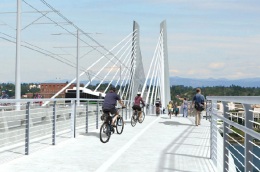
(Graphic: TriMet).
Rob Kremer, a talk-radio host and the Portlander behind a Republican-donor-funded movement to oppose “Portland creep” in Clackamas County, raised eyebrows on Friday afternoon when he said on Oregon Public Broadcasting’s Think Out Loud radio program that TriMet’s new Tilikum Crossing bridge is a “symbol of dysfunctional transportation priorities.”
About 12 minutes into the program, Kremer shared his strong objections to the bridge because it won’t allow access for private automobiles:
“I’m not quite sure about this name Tilikum. They say it means people, tribes and relatives — I think it means streetcars, buses and bicycles in Portland. They can call it Tilikum all they want but the real name of this bridge, by the people, will always be the ‘Autoban’ … And it will always be a symbol of TriMet’s, Metro’s and Portland’s dysfunctional transportation priorities.
To think we’re building a bridge across the Willamette … the first bridge in who knows how long, and not allowing cars to cross it is not only insane, but it’s a symbol of dysfunction.”
You can hear the exchange below (begins at about 12:46):
A couple minutes later, while challenging support for the bridge expressed by another guest (Bitch Media Online Editor Sarah Mirk, who said she doesn’t own a car), Kremer claimed that the bridge is an example of “priorities completely out of whack” because “97% of the trips are by car.”
He was off by about 911,000 trips per day. In fact, non-car modes carry 16 percent of Portland-area trips, according to a 2011 survey of 17,000 Oregon households.
According to the Oregon Household Travel and Activity Survey, 9 percent of trips by Portland-area residents were on foot, 4 percent were by transit and 3 percent were by bike. That’s a bit different than the ratio for commute trips, which account for about one in five trips Americans make; 19 percent of Portland-area commutes are by foot, bike or transit, according to the same estimates.
Inside Portland city limits, meanwhile, 28 percent of trips are by walking, biking or transit.
Kremer and his wife Mary, a 2010 state Senate candidate, own a house near the Willamette in Southwest Portland, but it’s easy to see why he might be confused. Not every U.S. city has chosen to make walking, biking and transit so safe and convenient. Nationwide, their share of trips is only — well, actually it’s 14 percent.
Until last year, Kremer was a political consultant who also served as treasurer of the Oregon Republican Party and director of the Oregon Transformation Project PAC, which drove an anti-land-regulation majority into power in Clackamas County in 2012. Kremer stepped down from those roles in early 2013 to focus on advocacy for charter schools.
It’s easy to laugh at inaccurate grandstanding like this — he presumably remembered the ratio for biking and forgot that there are any other alternatives to driving everywhere — but I have to say: if I thought, even subconsciously, that after all of Portland’s work to make things better for active transportation, 97 percent of trips were still happening by car, I’d be pretty upset, too.
Kremer, who would obviously be in a better mood if he read BikePortland more religiously, didn’t respond to an emailed request for comment Friday afternoon.
Editor/publisher Jonathan Maus contributed to this story.

